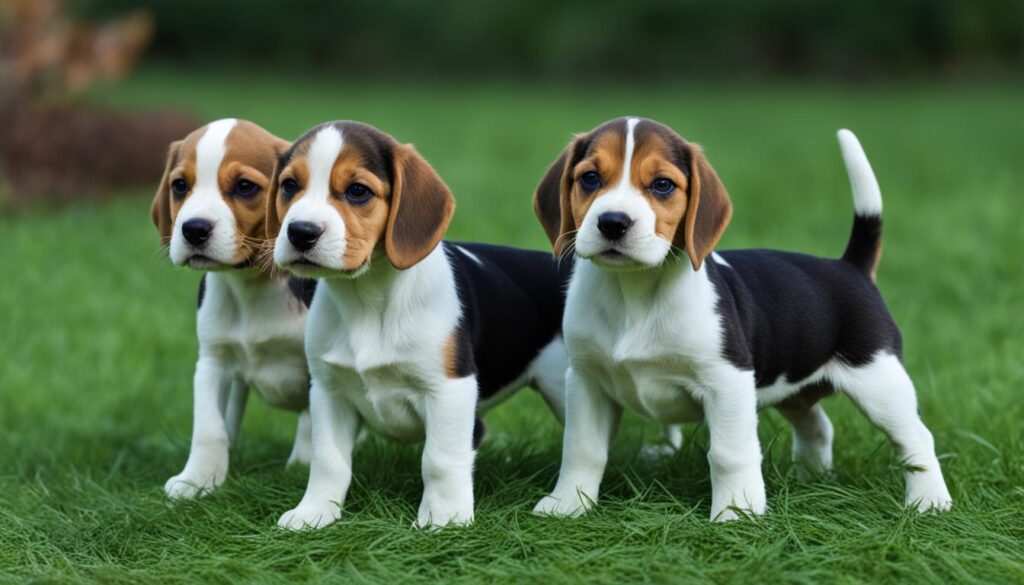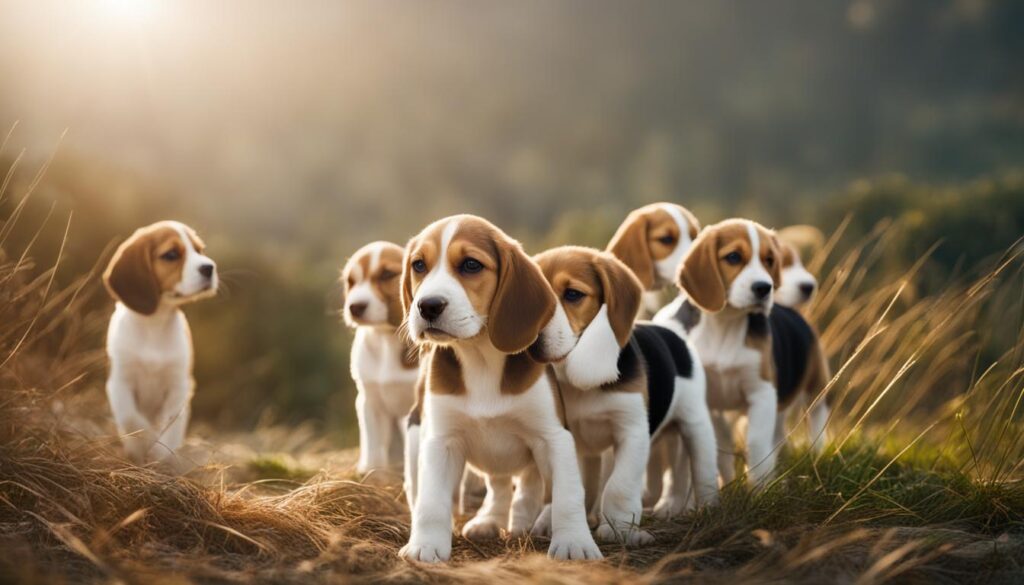Physical Address
304 North Cardinal St.
Dorchester Center, MA 02124

Have you ever wondered when beagle puppies change color? Well, you’re in the right place! Beagles, like many other dog breeds, go through a remarkable color transformation as they grow and develop. This color change is a fascinating process that every beagle owner should be aware of. In this article, we will dive into the stages of beagle puppy color transformation, explore the timeline of their coat development, and discover when these adorable puppies start to show their true colors.
Beagles have a variety of color combinations in their coat. There are ten primary colors that make up these combinations, including black, white, brown, tan, lemon, fawn, red, redtick, blue, and bluetick. The American Kennel Club recognizes 25 different color combinations for beagles. The color of a beagle’s coat can change throughout their lives, especially during their puppyhood.
Beagle puppies go through different stages of coat development, resulting in changes in color and pattern. During their early stages, beagle puppies typically have a black and white coat. However, as they grow, their coat color undergoes a transition, with the black areas gradually fading and other colors or shades becoming more visible.
It’s important to note that beagle puppies may experience brighter or lighter coat colors during their first few months of life. The shape and size of color patches may also change as they continue to develop. Breeders often have three opportunities to change the coat color listed on the beagle puppy’s AKC registration papers, acknowledging the ongoing nature of these changes.
As beagle puppies grow into adults, the color of their coat may continue to change, although the transformations become less noticeable. Aging can bring about further changes in a beagle’s coat, with some dogs showing signs of graying. Loss of color pigments can result in lighter-colored hair, similar to how humans’ hair turns gray as they age. While not all beagles will experience this, it is a common occurrence in the breed, especially after six years of age.
Aside from natural aging, other factors, such as hormonal problems or conditions like vitiligo, can also contribute to drastic color changes in a beagle’s coat. Direct sunlight exposure can also cause a loss of color pigmentation. Therefore, it’s essential to provide proper care and protection to maintain the coat’s color and health.
Beagle puppies are mostly born with a black and white coat. However, as they grow, their black areas start to fade, and other colors or shades become more visible. The color of a beagle puppy’s coat can brighten or fade during the first few months, and the shape of the color patches may change. Beagle breeders are given three chances to change the color of the puppies on their AKC registration papers.
During the early stages of a beagle puppy’s life, their coat undergoes a fascinating transformation. It is a sight to behold as the once-dominant black areas begin to fade away, allowing other colors to take center stage. This beautiful color change is a natural part of their development and adds to the charm of owning a beagle.
The transition in coat color can vary from puppy to puppy, and each one may experience their own unique journey of color transformation. Some puppies may have patches of light brown or tan areas emerging, while others may develop a reddish hue. The possibilities are endless, and it’s a delightful surprise to witness the changes unfold.
Not only does the color change in beagle puppies, but the shape and pattern of the color patches may also evolve. What initially started as solid black areas may break up into smaller spots or merge together, creating intriguing patterns. The transition in both color and pattern adds depth and character to a beagle’s coat, enhancing their overall appearance.
As the color of a beagle puppy’s coat shifts and transforms, so does their individuality. It’s like watching a work of art come to life.
It’s important to note that the color change in beagle puppies is not a one-time event. It occurs gradually over several months, with the most significant changes happening during their early stages of development. Beagle owners may find themselves marveling at their puppy’s coat, eagerly anticipating the next stage of color transformation.
Beagle puppies’ color change is so remarkable that breeders are even given the option to make adjustments on their AKC registration papers. This recognition further emphasizes the significance of color in a beagle’s identity.
As beagle puppies grow, their coat continues to evolve, although at a slower pace compared to their early stages. The color transitions become less noticeable as they mature, but the underlying beauty remains intact.
Each beagle’s color change journey is unique, making it a fascinating experience for both the owner and the puppy. The gradual shifts in color, shape, and pattern add to the charm and allure of these lovable companions.

As beagles age, their coat can undergo changes in color. Just like humans, beagles may start to show signs of graying as they grow older. The loss of color pigments in their coat can result in lighter-colored hair, adding a touch of wisdom to their appearance. While not all beagles experience this, it is a common occurrence in the canine world.
Color change due to aging is usually more noticeable after a beagle reaches six years of age, marking the transition into their senior years. At this stage, you may start noticing subtle variations in their coat color, with lighter shades replacing the vibrancy of their youth. These changes are a natural part of the aging process and contribute to the unique beauty of mature beagles.
“Just like a fine wine, beagles age with grace, and their changing coat color adds character to their charming personalities.”
While it’s essential to embrace these color changes as part of your beagle’s journey, it’s crucial to ensure their overall health and well-being. Regular grooming routines, a balanced diet, and veterinary check-ups can support healthy coat development as they age.
“Remember, age is just a number, and the changing colors of a beagle’s coat are a testament to the rich tapestry of their life.”

Besides aging, there are several other factors that can contribute to a change in a beagle’s coat color. These factors can affect the pigmentation and texture of their fur. Let’s explore some of them:
These factors can influence the natural coloration of a beagle’s coat, leading to intriguing transformations and variations. Understanding these influences can help owners appreciate the uniqueness of their beagle’s appearance.
Image:
| Factors | Impact on Coat Color |
|---|---|
| Hormonal Problems | Alters color and texture of the coat |
| Vitiligo | Causes depigmentation, especially on the face |
| Sun Exposure | Results in a loss of color pigmentation |
Beagles’ coats continue to change color throughout their lives. While the most significant color changes occur during their puppyhood, the color transition remains ongoing. It is important to understand that the color change in beagles is a natural part of their development and should be expected.
During the first few months of a beagle puppy’s life, their black areas fade, and other colors or shades become more visible. This color change is most noticeable during this stage, with the black coat turning into shades of brown. However, as beagles mature, the changes in their coat color become less pronounced and noticeable.
The exact timeline for when beagles stop changing color can vary from dog to dog. While some beagles may reach their final coat color by around 6 months of age, others may continue to undergo subtle color changes well into their adulthood.
It is fascinating to witness the transformation of a beagle’s coat color and see the unique combinations of hues that emerge. The ongoing color change adds to the charm and individuality of each beagle. Whether their coat becomes lighter or darker as they age, the variations in color make beagles even more beautiful and interesting companions.
Beagle owners should embrace and appreciate the ever-changing nature of their pet’s coat. It is a testament to their genetic heritage and adds to the overall appeal of the breed. Understanding the timeline of beagle puppy color changes can help owners anticipate and enjoy the evolving beauty of their beloved pets.
Seeing the gradual transformation of a beagle’s coat and being part of their journey as their colors shift and blend is a truly rewarding experience. So, if you have a beagle puppy, cherish each stage of their color change and embrace the unique beauty that comes with it.
Beagle puppy coat color changes are a fascinating part of their development. As these adorable pups grow into adulthood, their coat goes through a remarkable transition known as the “break.” Initially born black and white, their black areas gradually fade and transform into beautiful shades of brown. This unique color change is most noticeable during their puppyhood.
Throughout their lives, beagles continue to experience coat color transitions, although these changes become less prominent as they mature. Understanding the stages of beagle puppy color transformation can help us appreciate and enjoy the beauty of their individual coat development.
Witnessing the evolving colors and textures of a beagle puppy’s coat is truly a delight. From the black and white hues to the emergence of browns, beagles captivate us with their unique and ever-changing appearance. These color shifts add charm, personality, and character to our furry friends. So, sit back, observe, and embrace the wonder of your beagle’s coat journey.